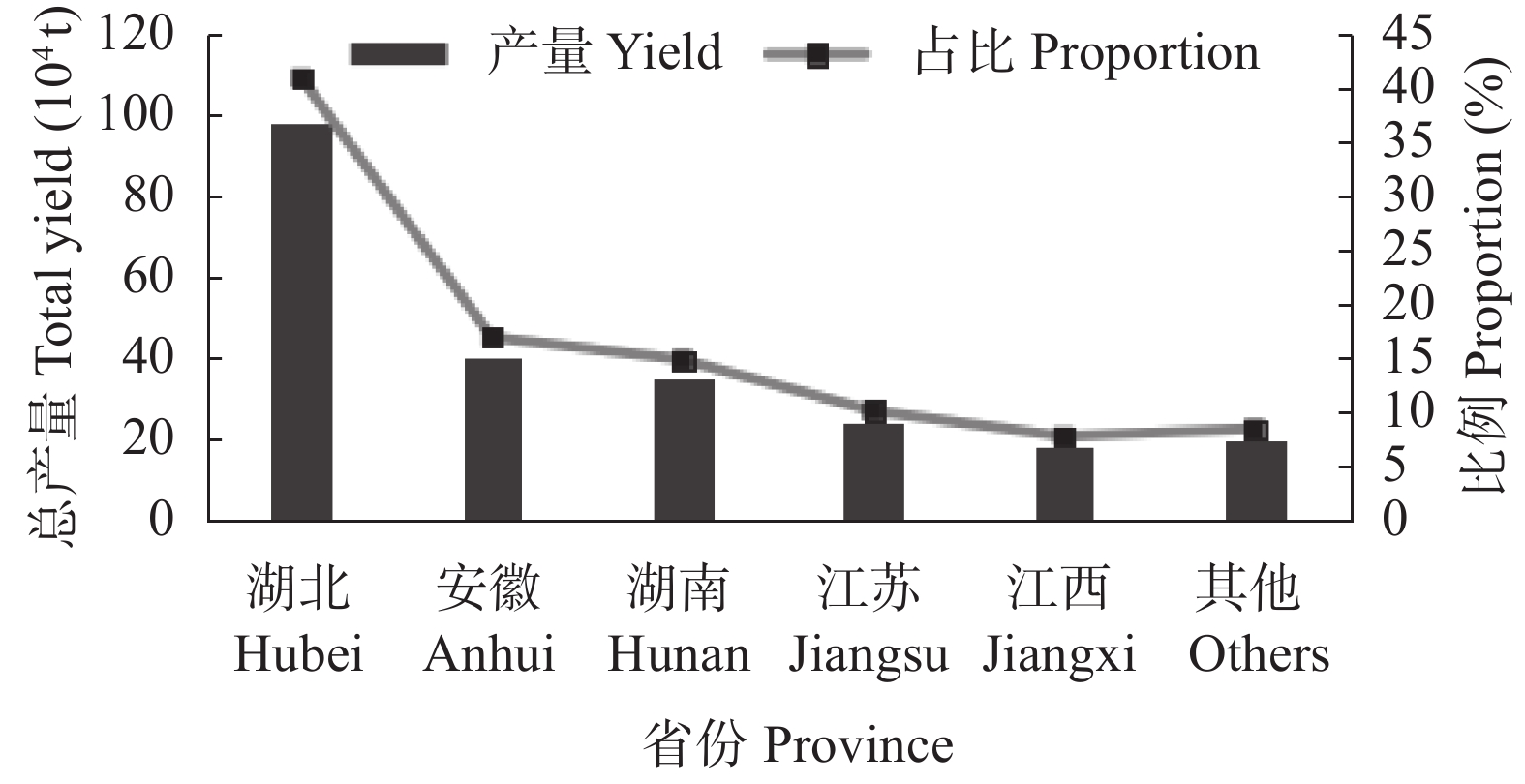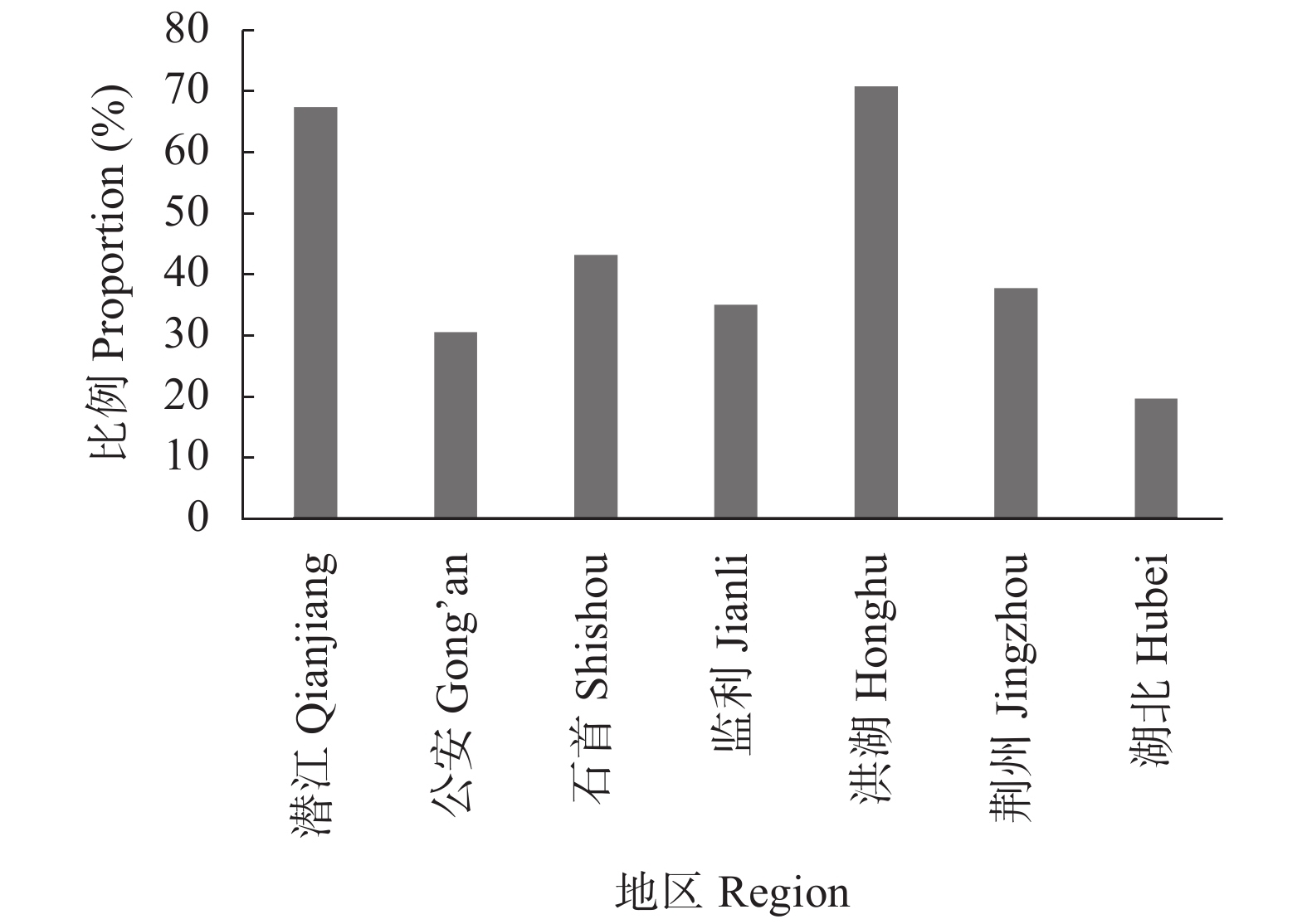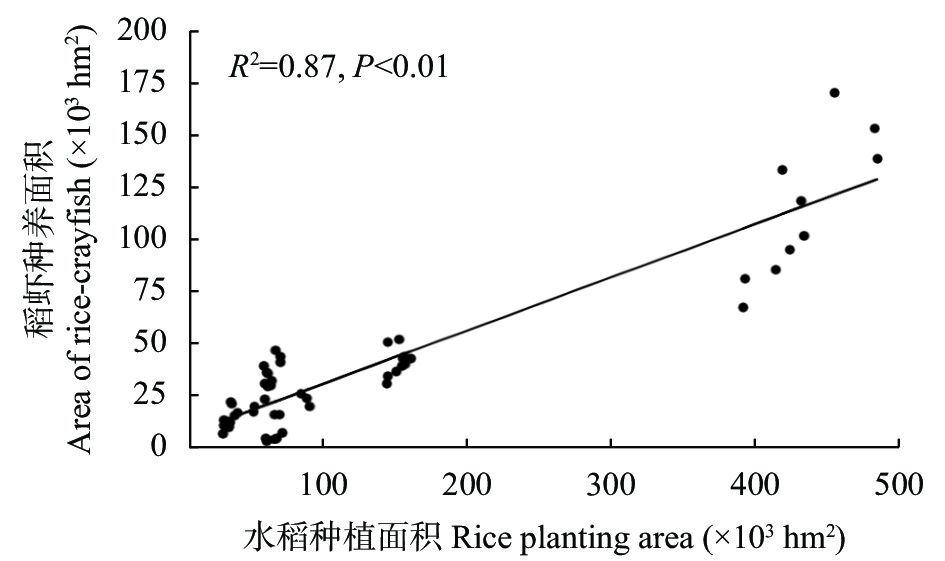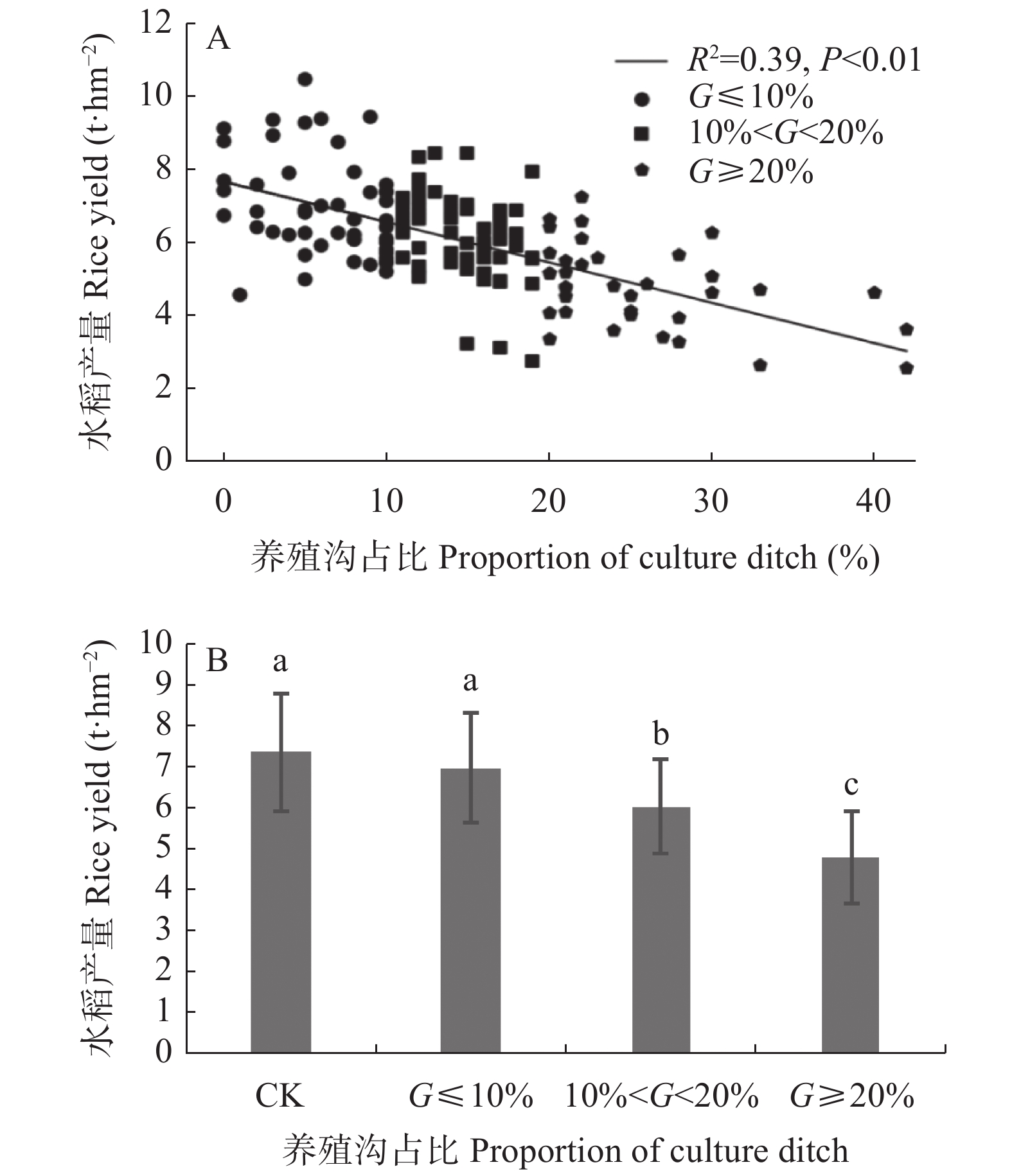-
摘要: 稻虾种养模式是指将小龙虾的养殖与水稻种植相结合的一种复合种养模式, 该模式因其较高的经济效益, 近些年在全国发展迅速。在稻虾种养模式大面积推广的背景下, 有关稻虾种养模式对粮食产量安全的问题受到关注。本文通过多年定位试验、不同生态区农户调查和湖北省近10年统计年鉴资料, 对稻虾种养稻田的粮食安全问题进行分析。结果表明: 1)稻虾种养提高了农民的种稻积极性, 扩大了水稻种植面积, 增加了水稻总产量。稻虾种养面积与水稻种植面积呈显著正相关, 稻虾主产区湖北省潜江市、荆州市和湖北省的水稻种植面积与10年前相比分别提高77.77%、16.23%和12.20%, 水稻总产量分别提高68.12%、16.61%和20.49%。同时近10年湖北省夏收粮食(小麦等)产量维持稳定。2)湖北稻虾产区养殖沟占比(G)平均值为13.42%, G在一定程度上会影响水稻产量。在不考虑G情况下, 与传统稻田单作相比, 稻虾种养水稻产量提高17.63%。当G≤10%时, 稻虾种养水稻产量略低于传统单作, 差异不显著, 但是10%<G<20%和G≥20%条件下, 水稻产量显著降低, 分别降低18.19%和34.81%。3)稻虾种养发展区存在优劣势差异。水稻、小龙虾产量的表现在江汉平原、鄂东沿江平原优于鄂中北丘陵。因此按照G≤10%的标准规范稻虾模式田间工程建设, 坚持因地制宜地发展稻虾模式, 可在维持稻虾收益的同时保持水稻粮食安全, 是确保我国稻虾产业持续健康发展的重要保证。Abstract: Rice-crayfish coculture (RC) refers to an integrated agriculture mode that combines crayfish breeding and rice planting. This mode has developed rapidly in China in recent years owing to its high economic benefits. The effect of large-scale promotion of RC on grain yield has attracted attention. Thus, to explore whether the large-scale popularization of RC has an adverse simultaneous impact on local rice yield and total grain yield, the influence of the proportion of cultivation ditches on rice yield was analyzed, the development status of RC in different regions was compared, and whether RC is suitable for further promotion was investigated. This study analyzed the impact of the RC mode on rice yield through long-term positioning experiments, household surveys in different ecological areas, and statistical yearbook data from Hubei Province over the past 10 years. The results showed the following: 1) RC expanded the area, increased the total yield, and improved farmer enthusiasm for planting rice. There was a significant positive correlation between the RC mode planting area and the rice planting area. The rice-planting area in Qianjiang City, Jingzhou City, and Hubei Province increased by 77.77%, 16.23%, and 12.20%, respectively, and the total rice yield increased by 68.12%, 16.61%, and 20.49%, respectively, in recent 10 years. Simultaneously, the summer grain (wheat) yield in Hubei Province had remained stable over the last 10 years. 2) The average proportion of cultivation ditches of crayfish (G) in the Hubei RC-producing area was 13.42%, and G affects rice yield to a certain extent. Without considering G, the rice yield, when using the RC mode, increased by 17.63% compared to that of traditional rice monoculture. When G≤10%, the RC rice yield was slightly lower than that of traditional rice monoculture, but the difference was not significant. However, under the conditions of 10%<G<20% and G≥20%, rice yield significantly decreased by 18.19% and 34.81%, respectively. 3) There are advantages and disadvantages in RC development areas. The yields of rice and crayfish in Jianghan Plain and the plain along the river in eastern Hubei were better than those on the hills of central and northern Hubei. Previous research results showed that RC can stabilize the yield of rice under appropriate G conditions. Simultaneously, owing to the high economic effect of RC, an increasing number of farmers have joined the industry in recent years, which has promoted an increase in the total yield of rice in the regions. However, there are obvious regional adaptability differences in RC. Only in advantageous regions can give full play to their role in stabilizing grain yield and increasing efficiency. Therefore, the field engineering construction associated with the RC mode should be standardized according to G≤10%, and adhering to the development of RC mode according to local conditions can maintain rice and crayfish income and food security, which is an important guarantee for the sustainable and healthy development of the rice-crayfish industry in China.
-
-
图 2 2019年湖北省稻虾主产区稻虾面积占水稻种植面积比例
数据来源于《湖北省农村统计年鉴》(2011—2020), 监利、石首和洪湖属于荆州市。
Figure 2. Proportions of rice-crayfish area in the main rice-crayfish producing areas of Hubei Province in 2019
Date sources is Hubei Rural Statistical Yearbook (2011—2020). Jianli, Shishou and Honghu belong to Jingzhou City.
表 1 湖北省稻虾主产区近10年水稻种植面积与总产量
Table 1 Rice planting areas and total yields in the main rice-crayfish producing areas of Hubei Province in recent 10 years
年份
Year潜江 Qianjiang 荆州 Jingzhou 湖北 Hubei 水稻面积
Rice area (×103 hm2)水稻总产量
Total rice yield (t)水稻面积
Rice area (×103 hm2)水稻总产量
Total rice yield (t)水稻面积
Rice area (×103 hm2)水稻总产量
Total rice yield (t)2010 33.06 288 400 391.89 3 221 318 2038.17 15 578 100 2011 30.62 314 127 393.09 3 102 753 2036.17 16 169 100 2012 34.97 346 665 413.88 3 162 473 2017.88 16 513 800 2013 38.03 369 481 423.75 3 276 548 2101.15 16 766 358 2014 40.29 381 463 433.82 3 340 781 2143.95 17 294 700 2015 36.37 365 252 431.80 3 403 470 2188.46 18 106 900 2016 35.20 310 897 419.00 3 016 499 2130.97 16 935 179 2017 59.06 504 400 485.07 3 931 806 2368.07 19 271 639 2018 60.55 515 700 483.06 3 970 237 2390.99 19 656 224 2019 58.77 484 848 455.51 3 756 414 2286.75 18 770 598 数据来源于《湖北省农村统计年鉴》(2011—2020)。Date sources is Hubei Rural Statistical Yearbook (2011−2020). 表 2 湖北省稻虾主产区近10年夏粮面积与夏粮总产量
Table 2 Summer grain areas and total summer grain yields in the main rice-crayfish producing areas of Hubei Province in recent 10 years
年限
Year潜江 Qianjiang 荆州 Jingzhou 湖北 Hubei 夏粮面积
Summer grain
area (×103 hm2)夏粮总产量
Total yield of summer
grain (t)夏粮面积
Summer grain
area (×103 hm2)夏粮总产量
Total yield of summer
grain (t)夏粮面积
Summer grain
area (×103 hm2)夏粮总产量
Total yield of summer
grain (t)2010 28.56 91 420 122.08 404 488 1253.75 4 206 200 2011 29.99 108 052 128.10 409 527 1321.33 4 258 300 2012 36.83 111 472 134.56 428 365 1363.19 4 474 400 2013 30.09 113 704 136.05 476 100 1400.60 5 010 000 2014 29.96 110 600 135.79 474 600 1389.92 5 056 000 2015 29.94 104 200 136.29 450 400 1380.85 5 044 500 2016 30.31 106 100 138.04 458 800 1392.93 5 086 650 2017 30.63 103 942 184.77 532 398 1348.50 4 882 443 2018 29.99 87 700 175.76 530 898 1304.26 4 675 956 2019 28.25 84 617 171.17 522 094 1266.50 4 569 991 数据来源于《湖北省农村统计年鉴》(2011—2020)。Date sources is Hubei Rural Statistical Yearbook (2011−2020). 表 3 稻虾长期定位试验各年水稻产量
Table 3 Rice yield in each year of long-term rice-crayfish experimental site
t∙hm−2 年限
Year稻虾种养(不含养殖沟)
Rice-crayfish (excluding culture ditch)稻虾种养(含养殖沟)
Rice-crayfish (including culture ditch)稻田单作
Rice-monoculture2016 9.65±0.83a 7.61±0.74c 8.23±1.89b 2017 8.43±0.92a 6.64±0.88c 6.94±0.97b 2018 9.51±1.01a 7.49±1.03c 8.02±1.21b 2019 9.09±1.31a 7.16±1.46c 7.99±0.87b 2020 6.56±1.17a 5.13±1.33c 5.56±0.47b 同行不同小写字母表示不同处理间在P<0.05水平差异显著, 2020年产量偏低的主要原因是连续降雨的影响。Different lowercase letters in the same line indicate significant differences at P<0.05 level. The main reason for the low output in 2020 is the continuous rainfall. 表 4 2018年湖北省稻虾产区水稻和小龙虾产量
Table 4 Rice and crayfish yields in the rice-crayfish producing areas of Hubei Province in 2018
地区
Region水稻产量 Rice yield 小龙虾产量
Crayfish yield稻虾种养田 Rice-crayfish 传统单作田 Rice monoculture t∙hm−2 鄂东沿江平原 Plain along the river in East Hubei 6.72±1.32a 7.02±1.41a 1.32±0.70 鄂中北丘陵 Hills in Central and North Hubei 4.83±1.34b 7.37±1.24a 1.36±0.77 江汉平原 Jianghan Plain 6.12±1.54b 7.66±1.61a 2.23±0.97 同行不同字母表示差异显著(P<0.05), 水稻产量是包含养殖沟面积条件下的实际产量, 养殖沟占比在鄂东沿江平原、鄂中北丘陵、江汉平原分别为10.05%、25.63%和17.03%。Different letters in the same line indicate significant differences at P<0.05 level. Rice yield refers to the actual yield under the condition of including the area of culture ditch. The proportion of aquaculture ditches in the plain along the river in East Hubei, the hills of Central and North Hubei and the Jianghan Plain is 10.05%, 25.63% and 17.03%, respectively. -
[1] FOLEY J A, RAMANKUTTY N, BRAUMAN K A, et al. Solutions for a cultivated planet[J]. Nature, 2011, 478(7369): 337−342 doi: 10.1038/nature10452
[2] TILMAN D. Global environmental impacts of agricultural expansion: the need for sustainable and efficient practices[J]. Proceedings of the National Academy of Sciences of the United States of America, 1999, 96(11): 5995−6000 doi: 10.1073/pnas.96.11.5995
[3] TILMAN D, CASSMAN K G, MATSON P A, et al. Agricultural sustainability and intensive production practices[J]. Nature, 2002, 418(6898): 671−677 doi: 10.1038/nature01014
[4] DEKNOCK A, DE TROYER N, HOUBRAKEN M, et al. Distribution of agricultural pesticides in the freshwater environment of the Guayas River Basin (Ecuador)[J]. Science of the Total Environment, 2019, 646: 996−1008 doi: 10.1016/j.scitotenv.2018.07.185
[5] AHMED N, WARD J D, SAINT C P. Can integrated aquaculture-agriculture (IAA) produce “more crop per drop”?[J]. Food Security, 2014, 6(6): 767−779 doi: 10.1007/s12571-014-0394-9
[6] NAYLOR R, STEINFELD H, FALCON W, et al. Losing the links between livestock and land[J]. Science, 2005, 310(5754): 1621−1622 doi: 10.1126/science.1117856
[7] 胡亮亮. 农业生物种间互惠的生态系统功能[D]. 杭州: 浙江大学, 2014 HU L L. Ecosystem functioning of facilitation between co-cultured species[D]. Hangzhou: Zhejiang University, 2014
[8] 王强盛, 王晓莹, 杭玉浩, 等. 稻田综合种养结合模式及生态效应[J]. 中国农学通报, 2019, 35(8): 46−51 doi: 10.11924/j.issn.1000-6850.casb18040052 WANG Q S, WANG X Y, HANG Y H, et al. Combination modes and ecological effects of planting-breeding ecosystem in rice field[J]. Chinese Agricultural Science Bulletin, 2019, 35(8): 46−51 doi: 10.11924/j.issn.1000-6850.casb18040052
[9] 隆斌庆, 陈灿, 黄璜, 等. 稻田生态种养的发展现状与前景分析[J]. 作物研究, 2017, 31(6): 607−612 LONG B Q, CHEN C, HUANG H, et al. Analysis on the development status and prospect of ecological breeding in paddy field[J]. Crop Research, 2017, 31(6): 607−612
[10] 吴敏芳, 张剑, 陈欣, 等. 提升稻鱼共生模式的若干关键技术研究[J]. 中国农学通报, 2014, 30(33): 51−55 doi: 10.11924/j.issn.1000-6850.2014-1374 WU M F, ZHANG J, CHEN X, et al. Practical technology for improving rice-fish co-culture system[J]. Chinese Agricultural Science Bulletin, 2014, 30(33): 51−55 doi: 10.11924/j.issn.1000-6850.2014-1374
[11] 赵考诚, 马军, 叶迎, 等. 稻虾生态种养综合效应研究进展[J]. 作物杂志, 2021(2): 22−27 ZHAO K C, MA J, YE Y, et al. Research advance on the comprehensive effects of ecological farming of rice and shrimp[J]. Crops, 2021(2): 22−27
[12] 刘其根, 李应森, 陈蓝荪. 克氏原螯虾的生物学[J]. 水产科技情报, 2008, 35(1): 21−23 doi: 10.3969/j.issn.1001-1994.2008.01.011 LIU Q G, LI Y S, CHEN L S. Ecological culture of red swamp crayfish Procambarus clarkii[J]. Fisheries Science & Technology Information, 2008, 35(1): 21−23 doi: 10.3969/j.issn.1001-1994.2008.01.011
[13] 全沁果, 张泽伟, 陈铭, 等. 小龙虾的综合利用研究进展[J]. 食品研究与开发, 2019, 40(3): 213−219 doi: 10.3969/j.issn.1005-6521.2019.03.038 QUAN Q G, ZHANG Z W, CHEN M, et al. Research progress on comprehensive utilization of crayfish[J]. Food Research and Development, 2019, 40(3): 213−219 doi: 10.3969/j.issn.1005-6521.2019.03.038
[14] 全国水产技术推广总站, 中国水产学会, 中国水产流通与加工协会. 中国小龙虾产业发展报告(2021)[N]. 中国渔业报, 2021-06-21 National Aquatic Technology Promotion Station, China Fisheries Society, China Fisheries Circulation and Processing Association. China crayfish industry development report (2021)[N]. Chinese Journal of Fishery, 2021-06-21
[15] 曹凑贵, 江洋, 汪金平, 等. 稻虾共作模式的“双刃性”及可持续发展策略[J]. 中国生态农业学报, 2017, 25(9): 1245−1253 CAO C G, JIANG Y, WANG J P, et al. “Dual character” of rice-crayfish culture and strategies for its sustainable development[J]. Chinese Journal of Eco-Agriculture, 2017, 25(9): 1245−1253
[16] 许辉, 赵阳阳, 孙东岳, 等. 稻虾共作模式研究进展[J]. 中国农业科技导报, 2022, 24(2): 160−168 XU H, ZHAO Y Y, SUN D Y, et al. Progress in integrated rice-crayfish farming system[J]. Journal of Agricultural Science and Technology, 2022, 24(2): 160−168
[17] ZHANG J, HU L L, REN W Z, et al. Rice-soft shell turtle coculture effects on yield and its environment[J]. Agriculture, Ecosystems & Environment, 2016, 224: 116−122
[18] 李丽娜, 闫淋淋, 曹凑贵, 等. 稻虾共作系统中水稻生长及养分吸收对秸秆还田与投食的响应[J]. 华中农业大学学报, 2020, 39(2): 8−16 LI L N, YAN L L, CAO C G, et al. Effects of straw returning and crayfish feeding on rice growth and nutrient uptake in rice-crayfish ecosystem[J]. Journal of Huazhong Agricultural University, 2020, 39(2): 8−16
[19] HOU J, WANG X L, XU Q, et al. Rice-crayfish systems are not a Panacea for sustaining cleaner food production[J]. Environmental Science and Pollution Research International, 2021, 28(18): 22913−22926 doi: 10.1007/s11356-021-12345-7
[20] 宋世龙. 稻田水深对稻虾共作水稻、克氏原螯虾生长及其关键环境因子影响研究[D]. 扬州: 扬州大学, 2021 SONG S L. Effects of water depth in paddy field on the growth and key environmental factors of rice and crayfish in rice-crayfish intergrowth[D]. Yangzhou: Yangzhou University, 2021
[21] 姚义, 唐建鹏, 陈京都, 等. 稻虾共作与栽插密度对优良食味粳稻物质生产及其产量的影响[J]. 扬州大学学报(农业与生命科学版), 2021, 42(1): 98−104 YAO Y, TANG J P, CHEN J D, et al. Effects of rice-shrimp co-cultivation and density on material production and yield of good eating quality Japonica rice[J]. Journal of Yangzhou University (Agricultural and Life Science Edition), 2021, 42(1): 98−104
[22] 寇祥明, 谢成林, 韩光明, 等. 3种稻田生态种养模式对稻米品质、产量及经济效益的影响[J]. 扬州大学学报(农业与生命科学版), 2018, 39(3): 70−74 KOU X M, XIE C L, HAN G M, et al. The effects of three different ecological farming patterns on rice quality, yield and economic benefit[J]. Journal of Yangzhou University (Agricultural and Life Science Edition), 2018, 39(3): 70−74
[23] HOU J, STYLES D, CAO Y X, et al. The sustainability of rice-crayfish coculture systems: a mini review of evidence from Jianghan Plain in China[J]. Journal of the Science of Food and Agriculture, 2021, 101(9): 3843−3853 doi: 10.1002/jsfa.11019
[24] 吴雪, 谢坚, 陈欣, 等. 稻鱼系统中不同沟型边际弥补效果及经济效益分析[J]. 中国生态农业学报, 2010, 18(5): 995−999 doi: 10.3724/SP.J.1011.2010.00995 WU X, XIE J, CHEN X, et al. Edge effect of trench-pond pattern on rice grain and economic benefit in rice-fish co-culture[J]. Chinese Journal of Eco-Agriculture, 2010, 18(5): 995−999 doi: 10.3724/SP.J.1011.2010.00995
[25] 唐建军, 陈欣, 胡亮亮, 等. 稻渔共生生态系统中沟坑问题与最大允许沟宽的推算及应用[J]. 中国水产, 2021(4): 58−61 TANG J J, CHEN X, HU L L, et al. The analysis on the design of field ditches, and the estimation and application of the maximum allowable width of field ditches in rice-fish culture system[J]. China Fisheries, 2021(4): 58−61
[26] XIE J, HU L L, TANG J J, et al. Ecological mechanisms underlying the sustainability of the agricultural heritage rice-fish coculture system[J]. Proceedings of the National Academy of Sciences of the United States of America, 2011, 108(50): E1381−E1387
[27] KHUMAIROH U, LANTINGA E A, SCHULTE R P O, et al. Complex rice systems to improve rice yield and yield stability in the face of variable weather conditions[J]. Scientific Reports, 2018, 8: 14746 doi: 10.1038/s41598-018-32915-z
[28] 侯雯嘉, 耿婷, 陈群, 等. 近20年气候变暖对东北水稻生育期和产量的影响[J]. 应用生态学报, 2015, 26(1): 249−259 HOU W J, GENG T, CHEN Q, et al. Impacts of climate warming on growth period and yield of rice in Northeast China during recent two decades[J]. Chinese Journal of Applied Ecology, 2015, 26(1): 249−259
[29] 胡雅杰, 朱大伟, 邢志鹏, 等. 改进施氮运筹对水稻产量和氮素吸收利用的影响[J]. 植物营养与肥料学报, 2015, 21(1): 12−22 doi: 10.11674/zwyf.2015.0102 HU Y J, ZHU D W, XING Z P, et al. Modifying nitrogen fertilization ratio to increase the yield and nitrogen uptake of super Japonica rice[J]. Journal of Plant Nutrition and Fertilizer, 2015, 21(1): 12−22 doi: 10.11674/zwyf.2015.0102
[30] 徐国伟, 王贺正, 翟志华, 等. 不同水氮耦合对水稻根系形态生理、产量与氮素利用的影响[J]. 农业工程学报, 2015, 31(10): 132−141 doi: 10.11975/j.issn.1002-6819.2015.10.018 XU G W, WANG H Z, ZHAI Z H, et al. Effect of water and nitrogen coupling on root morphology and physiology, yield and nutrition utilization for rice[J]. Transactions of the Chinese Society of Agricultural Engineering, 2015, 31(10): 132−141 doi: 10.11975/j.issn.1002-6819.2015.10.018
[31] 陈宇眺. 栽培模式对水稻产量和氮肥利用率的影响及生理机制的研究[D]. 武汉: 华中农业大学, 2016 CHEN Y T. Effects cultivation patterns on rice yield and nitrogen use efficiency and its mechanisms[D]. Wuhan: Huazhong Agricultural University, 2016
[32] GUO L, HU L L, ZHAO L F, et al. Coupling rice with fish for sustainable yields and soil fertility in China[J]. Rice Science, 2020, 27(3): 175−179 doi: 10.1016/j.rsci.2020.04.001
[33] 张勇, 吴学兵. “虾稻共作”模式对国家粮食安全的影响研究−基于湖北省潜江市的调研[J]. 湖北农业科学, 2021, 60(23): 201−204 ZHANG Y, WU X B. Research on the impact of the “crayfish-rice cultivation” model on national food security: based on a survey in Qianjiang City, Hubei Province[J]. Hubei Agricultural Sciences, 2021, 60(23): 201−204
[34] 汪本福, 杨志勇, 张枝盛, 等. 基于稻虾共作模式的水稻绿色生产技术[J]. 湖北农业科学, 2017, 56(24): 4711−4713 WANG B F, YANG Z Y, ZHANG Z S, et al. Green production technology of rice based on rice-shrimp farming model[J]. Hubei Agricultural Sciences, 2017, 56(24): 4711−4713
[35] 陈松文, 江洋, 汪金平, 等. 湖北省稻虾模式发展现状与对策分析[J]. 华中农业大学学报, 2020, 39(2): 1−7 CHEN S W, JIANG Y, WANG J P, et al. Situation and countermeasures of integrated rice-crayfish farming in Hubei Province[J]. Journal of Huazhong Agricultural University, 2020, 39(2): 1−7
[36] HU L L, ZHANG J, REN W Z, et al. Can the co-cultivation of rice and fish help sustain rice production?[J]. Scientific Reports, 2016, 6: 28728 doi: 10.1038/srep28728
[37] 中华人民共和国农业农村部. SC/T 1135.1—2017, 稻渔综合种养技术规范第一部分: 通则[S]. 北京: 中国农业出版社, 2018. Ministry of Agriculture and Rural Affairs of the people’ s Republic of China. SC/T 1135.1—2017, Technical Specifications for Integrated Farming of Rice and Aquaculture Animal-partⅠ: General Principle[S]. Beijing: China Agriculture Press, 2018




 下载:
下载:



